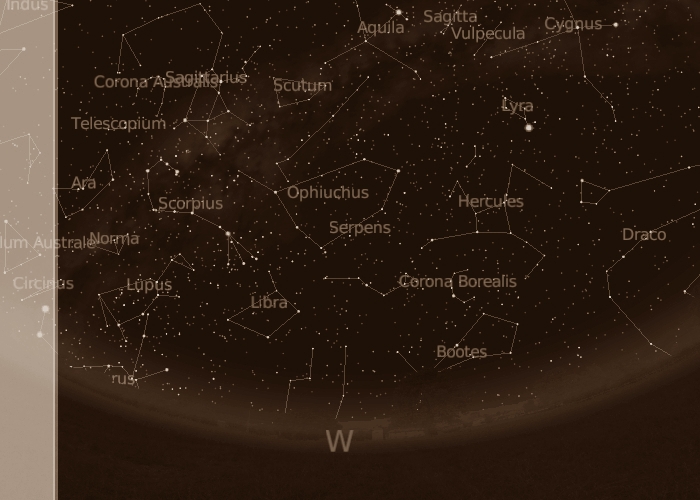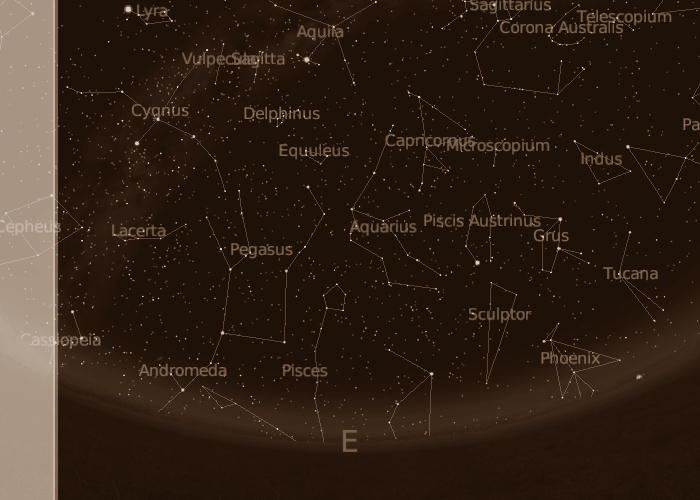Western Horizon
Eastern Horizon
![]()
Western Horizon
Eastern Horizon

We are in August, with the skies of the summer solstice, that is. The show keeps somewhat being southwest -the reverse of what is seen at the winter's solstice- with the band of Milky Way-embedded constellations. Lupus, the Wolf now is seen, with Scorpio, the Scorpion. The small constellation Libra, the Scales, ahead of the arch of stars which lies before Antares, was long linked to it, representing the claws of the insect. The two bright stars, well southwest and low, are the famed 'Pointers'. Sagittarius, the Archer, above Scorpio, is the famed home to our Milky Way Galaxy's center. As we live, with the Sun, inside the Milky Way Galaxy, we cannot see it under its well-known form of a spiral galaxy, like those popularized by those famed pictures of faraway galaxies, as we see it edge-on, from the inside only, with the form of the Milky Way. Sagittarius, at those times, allows for an access to the center of the Galaxy. Those curling veils of faint and luminescent myriads of stars is there where the bulge of old, yellowish stars is located. Sagittarius, further, is home to the galactic supermassive black hole, a place of the highest density in the Universe, whence nothing, not even light with its tremendous speed, can exit! The central black hole, in our Milky Way Galaxy, is the size of the orbit of Mercury! Under Sagittarius, about South, are found a series of typical southern constellations, like Corona Austrina, the Southern Crown, Telescopium, the Telescope, or Ara, the Altar. Should you come back to the western horizon proper now, Ophiuchus, the Serpent Holder, and its two Serpents either side, is another fine field of investigation. Bootes, the Herdsman, is now horizon-bound, as Hercules, northwest is a fine field too, providing access, moreover, to M13, the famed globular cluster. to a printer-friendly chart
West for the mid-northern latitudes. West for the mid-southern latitudes

East, first take a look to the southeast, which is harbouring several typical southern constellations, like Piscis Austrinus, the Southern Fish, Grus, the Crane, or Tucana, the Toucan. The bright star in Piscus Austrinus is the famed Fomalhaut, the name of which, in Arabic -'foum-al-haut'- means 'the fish's mouth'. Aquarius, the Water Bearer, is high now, with the Circlet to its lower left. The Great Square of Pegasus in another fine sight, well risen now and interesting to see. Should you turn North, at last, Cepheus, Cepheus is rising, and a part of Draco, the Dragon, is seen, as, high, you'll be able to find the 'Summer Triangle', this distinctive feature of the summer skies in the northern hemisphere. The Summer Triangle is a large triangle of three stars, which is composed of the three bright stars of the constellations Lyra, the Lyra, Aquila, the Eagle, and Cygnus, the Swan. The highest of those three is Altair, of Aquila as Vega, of Lyra, is to its lower left, and Deneb, of Cygnus, the lower right. to a printer-friendly chart
East for the mid-northern latitudes. East for the mid-southern latitudes
(color maps with Stellarium; printer-friendly charts with Cartes du Ciel, Patrick Chevalley)
Website Manager: G. Guichard, site 'Amateur Astronomy,' http://stars5.6te.net. Page Editor: G. Guichard. last edited: 12/28/2010. contact us at ggwebsites@outlook.com